#i tend to take screenshots of funny/interesting moments in things i watch/play and i have like so many of tdrp
Explore tagged Tumblr posts
Text

A terribly angled image of some silly Okazaki doodles I made while I was getting up to date with TDRP...... I adore her!!!!!!
Veronika's also here on my powerbank. these freaks, they're both iconic (and also my favourites from their respective series). The larger Hanano is a sticker I have no clue where to put yet so she's instead blue tacked onto my closet for now.......
some clearer(-ish) images ↓↓↓ konkonkonkon...
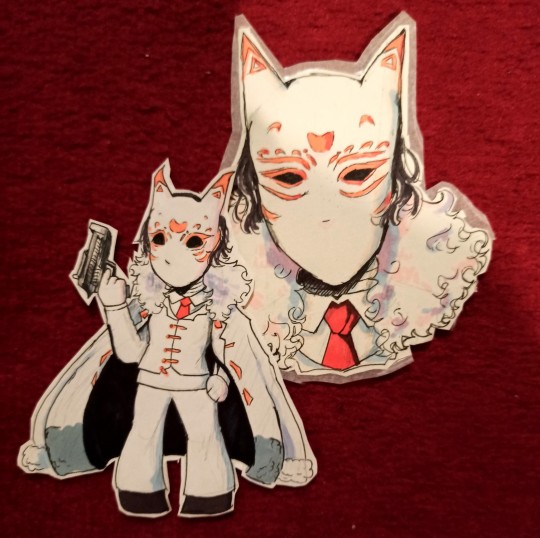

Perhaps I'll make some more polished digital fanart after I'm done with all the things i need to do. so much to do and so little time...
#tdrp#tetro danganronpa pink#tdrp spoilers#i guess? the gun? might as well tag for that#anyways#suffice to say chapter 3 both blessed and killed me#even if i was spoiled for victims and culprits#alas now my top two favs (hitomi and hanano) are now dead 💔#im seeing a lot of mentions of lore in 'staffside' which i assume are lore drops in an official discord server?#perhaps i should have a gander at that sometime#i tend to take screenshots of funny/interesting moments in things i watch/play and i have like so many of tdrp#mainly okazaki. my beloved#ive been doodling her smmmmmmmm#i often have the tendency to favour the egotistical and self-obsessed characteds in media#and . i find it so funnyi got so attached to okazaki before her theatrical trial reveal/breakdown#and then she's revealed as egotistical and self obsessed#the ego radar as my friends dub it#😭#did i even tag okazaki#okazaki hanano#hanano okazaki#should i tag veronika#hmm#veronika grebenshchikova
52 notes
·
View notes
Text
📱 Find Me (Tooru Oikawa) #1; Friendfinder
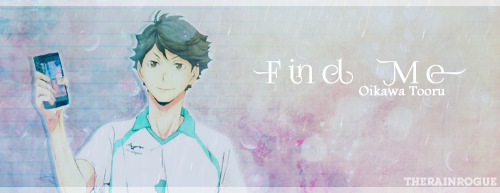
📑 Table of Contents
Author’s Note: Okay, so people have shown interested in this and I’m quite excited to share it with everyone, but also quite nervous because it’s not a straight SMAU and has some story aspects to it, as well. I’ll try not to write too much text oppossed to the message images, but I do hope you’ll share your opinion on what you think! ^~^)/ Also, the school is listed on the wiki as “Aobajohsai” rather than “Aoba Johsai” so that’s just what I’m going to go with because I already made the screenshots *thumbs up* Special thanks to @janellion for acting as a sort of beta reader to make sure it’s presentable! <3
━━━━━━༻📱༺━━━━━━
You sat at your desk, leafing through the fourth volume of the current manga series you were reading. There was still about ten minutes or so before class began and you had to pass the time somehow, even though you had already read that volume several times previously – you haven’t gotten paid for your part-time time job yet, so you couldn’t afford volume five until the weekend.
You were a second-year student at Aobajohsai, a private high school in the Miyagi prefecture. You weren’t very social, though, and didn’t have any friends, but you weren’t completely unhappy about this. People tended to bring a lot of trouble and drama, so you liked to avoid that, but… you did tend to feel lonely sometimes.
“Ne, ne, did you actually download it?”
“I did! I got paired up almost instantly and we have so much in common!”
You glanced to the side where two of your female classmates were sitting, huddled over their phones as they chatted excitedly between themselves. Were you wrong for eavesdropping? You didn’t know, but you were bored and they weren’t exactly being quiet with their words.
“So it really works? You can find a friend that quickly?”
“Yes!”
Now that had your attention. An app that helps you make friends? It sounded too good to be true, in your opinion, but… there was no harm in checking it out. If only they would say the name. You were too far away to be able to see what was on their screen, and if they caught you, that would be a very awkward situation indeed.
A third girl entered the room, stifling a yawn as she approached her two friends. “What are you guys looking at?”
“Friendfinder! It’s that new app that’s sweeping across Japan. All you have to do is sign up with an email and then you get paired with a random person on the app.”
“Sounds suspicious.”
“I thought so, too, but I’ve already found someone that shares all of my interests. They’re like my twin!”
‘Friendfinder? I think I saw an ad for that on the way home,’ you closed the manga and pulled out your phone from your bag. The only notification was a spam e-mail trying to sell real estate. You brought up the app store and searched the name, finding it at the top of the list with a five-star rating and millions of downloads. You hesitated for a moment, thumb hovering over the download button before finally pressing it. A minute later, it was added to your home screen.

You pressed the button, watching as the app started up.
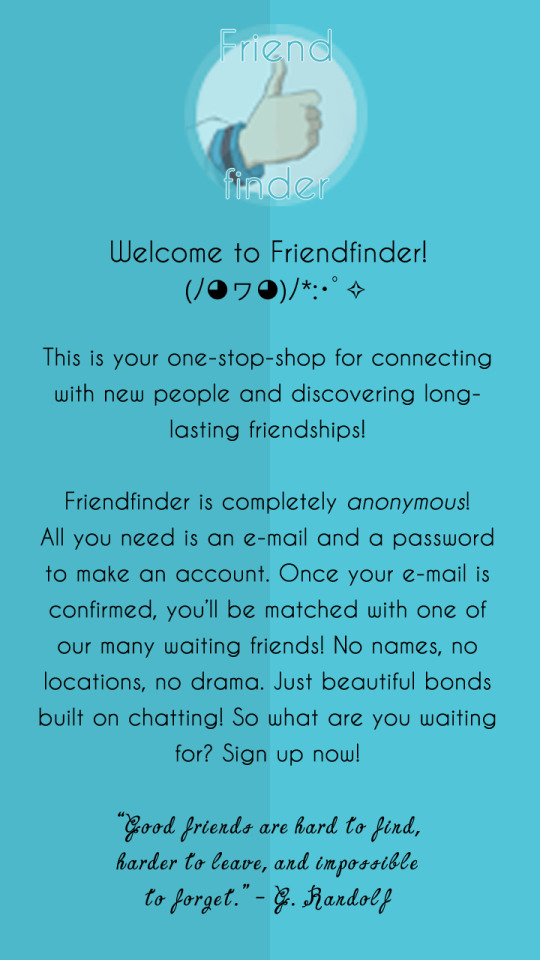
‘Well, it seems pretty cool. And it’s anonymous, too, but I wonder if there will be secret payments or something.’ You tapped the screen and the introduction message disappeared, showing off the login/register screen.

After entering your e-mail and choosing a ridiculous sequence of numbers, letters, and symbols to use as an acceptable password, you waited for the confirmation e-mail to come through. A minute later, you clicked on the link within the e-mail, which redirected to the app.
As you usually did, the first thing you clicked on was the settings to see what you could fiddle with and change, but there were only two options available. The first was to add a picture. You wanted to use this dope picture of an octopus that you had found just the other day, but the app only allowed you to choose from a pool of icons. The closest one to your personality was the IT clown chihuahua, though you almost chose the rain icon because it was gorgeous.
The other option was to turn the app into dark mode, which you tried, but it made your eyes burn so you returned it to its original state.

‘I’ve created an account and fiddled with the settings. Now what?’ You clicked around the few icons the app had, but only found information about the app, so you clicked back to the home screen.
‘Searching for a friend, please check back later! (ノ◕ヮ◕)ノ*:・゚✧‘
‘How long does it take, I wonder?’ You set the phone down, propping up your chin in your palm as you turned to look out the window. The sky was a clear blue, not a cloud in sight to help block out the cruel rays of the sun as they beamed down on the students.
The first bell chimed throughout the school and the students scattered to take their seats as the teacher, Sasaki Ryuko, stepped into the room, tapping her shoulder with the black book she always carried around with her.
As the day wore on, you tried to forget about the app, but you caught yourself checking the app on more than just a couple of occasions, but the same message still remained on the home screen. Why was this bugging you so much?
The final bell rang and, thankfully, you weren’t on cleaning duty today. You gathered your books, shoving them into your back without much concern before picking up your phone. ‘Don’t look, don’t look, don’t – crap, my phone is dead.’
Why had you forgotten to charge it last night? Oh right, you hadn’t, but your cat decided it would be funny to unplug it halfway through the night while YouTube played in the background, leaving you with very little battery by the time you reached school.
You stepped out of the school building, nearly running right into one of the volleyball club members, but he didn’t even notice you as he rushed past into the building. This was typical, though. You were the invisible character with very little presence, but you liked to think that made you special, like Kuroko from Kuroko no Basket.
You started on your way home, admiring the way the sky turned to shades of orange and red, like a fruity sorbet. Too bad the temperature couldn’t match that sentiment.
━━━━━━༻📱༺━━━━━━
▸n e x t
📜 Read more by checking out my masterlist 📜
If you enjoy my writing, please considering tipping me on Kofi or Cashapp. Every little bit helps and means a lot, thank you so much ^~^)/ If you can’t afford to do so, that’s okay, too, thanks for reading!
Tag List: @the-broken-halo-writer @nekoma-hoe
#find me#series#smau#anime#haikyuu#haikyuu!!#hq#oikawa tooru#tooru oikawa#writing#creative writing#writeblr#scenario#scenarios#anime scenarios#anime scenario#fanfiction#fanfic#fanfics#anime fanfic#anime fanfics#reader insert#reader-insert#reader
6 notes
·
View notes
Text
A look at the old FMA Fangame Bluebird’s illusion
Hey there. One of the more interesting things to come out of the FMA fandom is this fanmade visual novel called Bluebird’s illusion. It was made in October 2004. I’ve recently tried it out so why don’t I share?
It’s based on the FMA manga but was clearly heavily influenced by the anime as well with it’s cute artstyle and much of the music. The manga was of course far from finished at this point and perhaps what drew plenty of attention to this little fanproject was its speculations. (And the impressive art.)
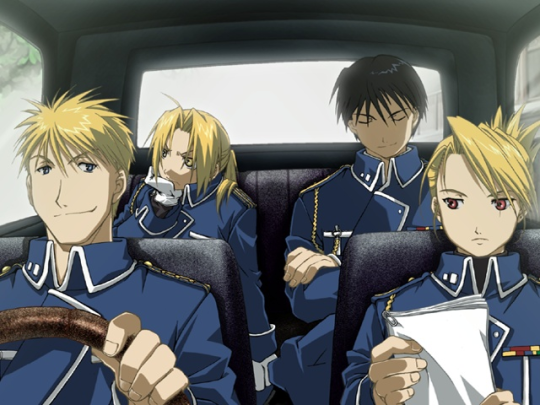
So, the story takes place in a seemingly happy future where Ed has restored his brother’s body and now lives with Al in a lovely house in Central. He still works for the military and has just started a new job as the Fuhrer’s secretary. Mustang is also around, of course.
However all is not well... (Long post by the way).
(I’m going to be spoiling this games plot pretty liberally just for the warning.)
It is called Bluebird’s illusion because the brother’s seeming happiness is just an illusion that cannot last. It is revealed that in order to restore Al’s body, Edward made some sort of deal with the Homunculi. However, his current body isn’t good enough to hold his soul and it’s starting to disappear. Plus the homunculi are still watching in the background.
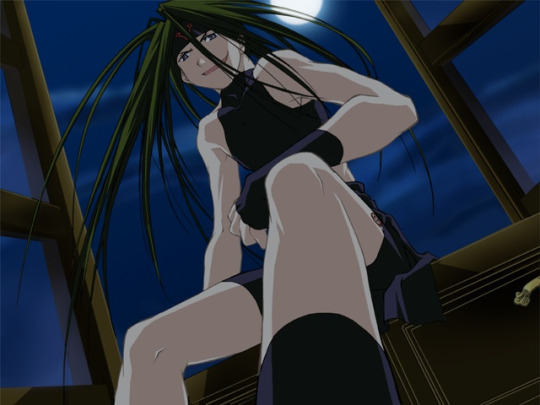
The game at first is pretty lighthearted with lots of jokes about Ed’s height, about Roy’s avoidance of paperwork, Breda’s fear of dogs etc. and the beginning is honestly pretty boring to play, in my opinion. Yet, it gets darker and in fact this game has no happy endings.
There are three main endings to this game plus one joke ending.
The most infamous ending is definitely the Pride!Ed ending.
Ed gets taken into the basement beneath Central HQ where the Homunculi’s Father awaits to use Ed to fulfill his vision of creating a new, perfect world. This happens in every ending actually.

The Homunculi’s Father is Hohenheim, by the way. (As I said, it’s following the manga but at the time it was created it was not yet clear that Father and Hohenheim were different people.) He speaks to Ed with a strange amount of fondness, calling him his most beloved son. (Which is quite something when its in front of the other Homunculi. I found this a really interesting dynamic)
Ed of course tries to resist, even with Hohenheim-Father promising to create a new permanent body for Al. He is held captive in the basement for five days before someone comes to rescue him. In that time he gets pretty abused by Envy but manages to disrupt the Homunculi’s plans some.
In this ending, Roy and Al come to save Ed but things go rather badly.
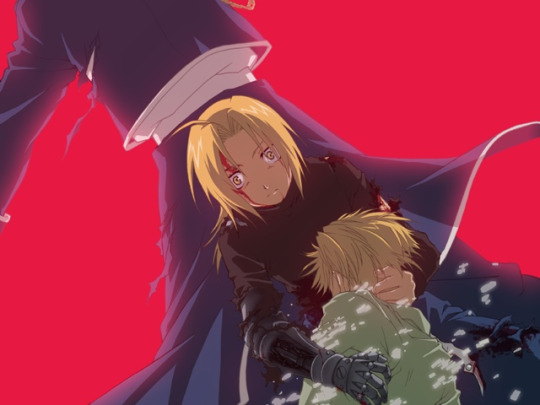
Both Roy and Al are defeated and dying (from facing Bradley(AKA Wrath) and Envy) so Ed, in his desperation and heedless of his own wounds, attempts a transmutation to bring them both back. All his efforts bring the basement crushing down and almost no one survives.
Seeing how Ed is not fully dead and the great power he possesses, Hohenheim-Father decides to bring him to life as the Homunculus Pride (A name he has never given to anyone before as he felt he had never had any children worthy to bear the title until now.)

Ed’s pretty much dead inside however. Pride is a cold, heartless creature who can’t seem to remember who he was. His new life seems to feature following Envy around (the only other Homunculus left.)
For all the love around Pride!Ed, the game only has this one screenshot, featuring an admittedly really cool design. (I love how he’s got two arms again but only one has a long sleeve). If you search for fanart there’s loads of Pride!Ed with this design. (It’s also rather impressive how this game predicted a Homunculus could be made out of a human as this was before Greedling existed and the method seems pretty similar.)
So, that was the real downer ending, (Roy dead, Al dead and Ed having lost himself). The other two endings hit closer to bittersweet.
If you go down the Al path in the game, by going home early each day and spending time with Al, you can unlock the Veg!Ed ending.
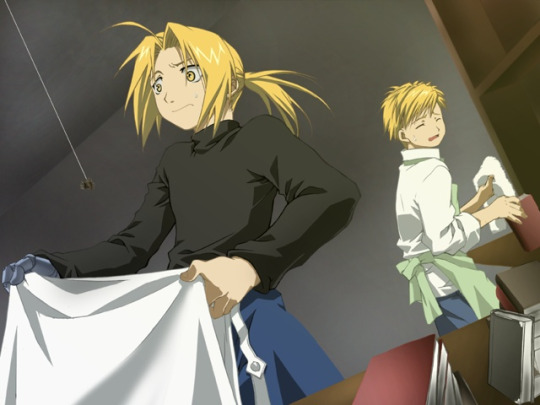
So, you do things like agreeing to help Al with housework and agree to go out with him on your day off and you deal with the serial killer plotline. (Yeah, that’s a thing, it’s a little weird.)
Anyway, this time when Al and Roy come to rescue Ed from the basement, Al is particularly self-sacrificing. Actually this end kind of reminds me of the end of the anime. I’m sure you can see why.

Envy stabs Al through the chest and so a distraught Ed decides to sacrifice himself to save his brother. He trades his soul for a new body for Al.

Al lives this time, (As does Mustang) and his body is restored permanently. However Ed has given up his soul. He isn’t quite dead - he’s physically alive but unresponsive. Al takes him back to Risembool and continues to talk to and take care of Ed in his vegetative state, hoping his brother will some day respond to him.

But there’s no sign of any recovery.
...
Right, the next ending is known as the Roy end. This is the ending you get if you follow Roy’s storyline.
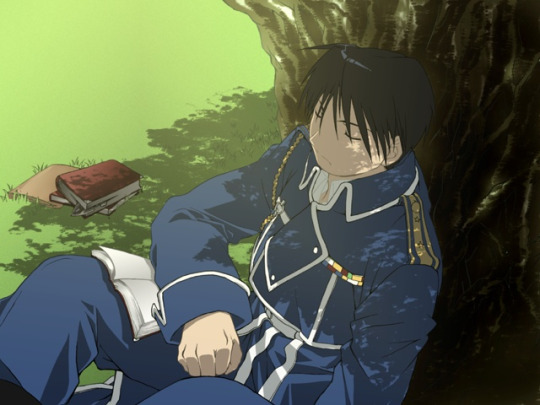
His storyline also deals with him remembering Hughes, who’s been dead for quite a while. You’ll notice in the picture above that one of the books has one of Hughes’ knives inside.
In this storyline you are invited to go out with Roy on your day off rather than going alone or with Al. It includes getting in a fight with him at one point.
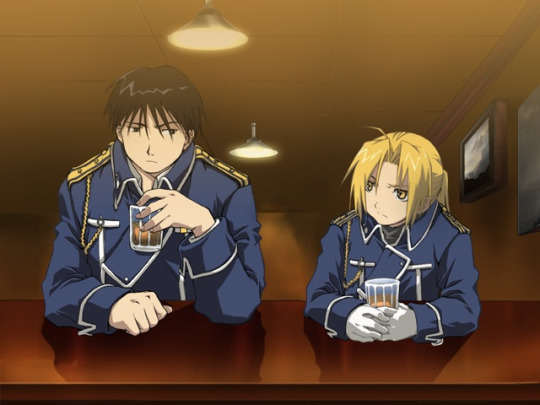
(They go into a pub and initially Roy orders two alcoholic drinks. Then he corrects himself and orders Ed something non-alcoholic. His first order had been for Hughes.)
Sadly, this ending is bittersweet as well. Al and Roy go into the basement to save Ed but this time Ed can’t save his brother. Alphonse disappears permanently. Ed’s still messed with the homunculi’s plans as he does every time and Roy and Ed manage to get out alive though Ed’s crying.
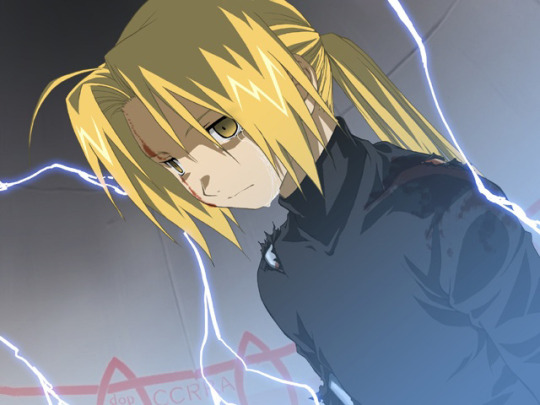
Ed is extremely broken by the loss of his brother. For the next two weeks Ed locks himself away in his house alone, willing himself to believe his brother isn’t truly gone. Then Roy, who is now the Fuhrer, comes to see Ed. He’s cold as ever, telling Ed that his brother’s gone and that he needs to move on and start living, that Al would want him to be happy.
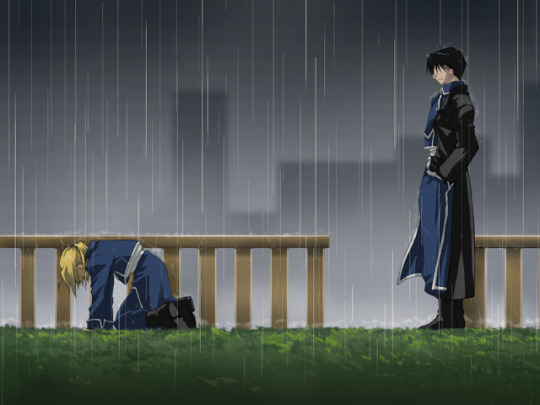
Ed does start to move on, and continues his life by working under Roy in the military. (For RoyEd shippers this could lead into an angsty relationship between the two in this ending. It’d be a pretty good dynamic.)
So, how about the last ending - the joke ending? It’s called the Tea alchemist ending. In this game, one of Ed’s jobs has been to serve tea every day to the Fuhrer. Yeah.
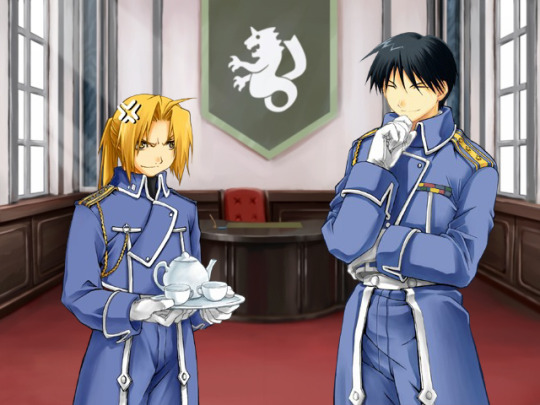
To get the tea ending you have to go down the King Bradley route. Basically you need to serve tea to him first every day and work overtime every day. On your day off, Bradley should call you and asks you to come into work on your day off. If you agree then Ed gets a permanent position of serving the Fuhrer as the Tea Alchemist and he never gets taken down to the basement.

(The person patting Ed’s head in the above image is Fuhrer Bradley by the way.) Working overtime every day has Ed get closer to the Fuhrer.
Ed gets given some cookies made by the Fuhrer’s wife. Another time, Ed falls asleep and looks absolutely adorable on the couch. Another day, Selim calls Ed and they have a friendly chat. Selim says he wishes he could see his father more often. Then the next day, Selim has gone missing and Ed is able to tell them where to find him. King Bradley is very grateful, hence the fatherly pat on the head. Honestly, this might have been the most surprising storyline for me in the game. I didn’t expect anything like it at all (whereas I knew about the dark endings).
So that’s all the endings in this game. The only other thing to mention would be all the fanservice stuff. If you ship Royed, EdAl or Edvy, this game gives you fodder for all these ships. (Or if you don’t ship them then you can just ignore it pretty easily).
Of all the character designs in the game, Envy’s is probably my favourite to be honest.
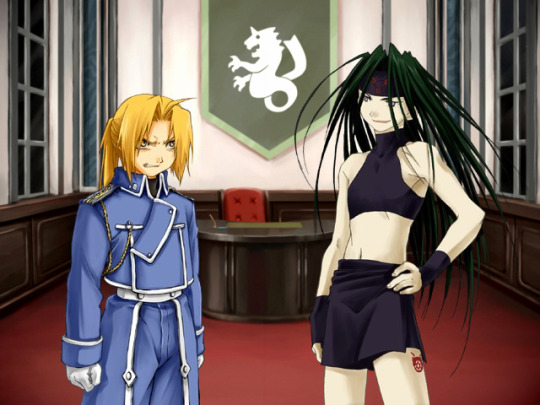
I love how his spiky hair seems to be all wildly different lengths and, well, just everything about his design. He’s as cruel and smug as ever of course. (When I say there’s shipping fodder, there’s no tender moments just typical Envy tormenting Ed and whatever his companionship with Pride is supposed to be.)
Roy is probably the one with the most obvious shipbait. At one point he convinces Ed to wear a dress to disguise himself as a girl. If that sounds random and fanservicey, it certainly is.
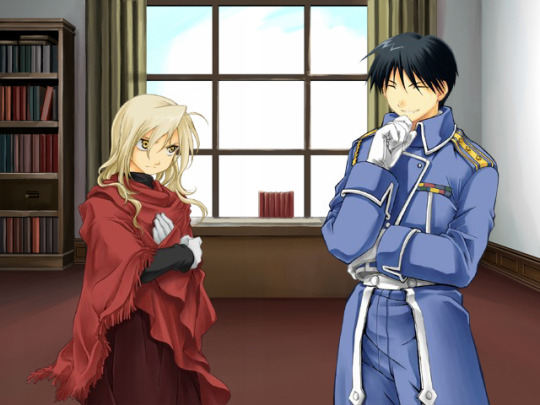
(Yes Roy looks that smug for pretty much the entire game.) He and Ed are practically constantly arguing.
Ed meanwhile, looks incredibly cute throughout the game.

(His pajamas are adorable. It’s has little cartoon Alphonse heads on it)
All versions of human Alphonse tend to look pretty good, I find. And this game does not disappoint in this regarding. For an obvious bit of fanservice, this game gives a particularly random shot of Al in the shower. (Getting that particular event was also kind of annoying and random.)

Yeah, there’s no explanations for some things.
Oh, this isn’t necessarily fanservice or anything but I thought that Breda’s design looked surprisingly good, of all people.

It’s the casual open uniform look. Makes him feel big and strong.
Finally there’s also a few outtakes that become available if you complete the right parts in the game. Most of them weren’t much to talk about but I found the one between Wrath!Bradley and Father Hohenheim to be rather funny.
It’s a silly outtake so it starts with Hohenheim commenting that Wrath is a good and dutiful son to him. Then he notes that Bradley is a father too and asks how Selim is. Wrath replies that Selim is the cutest boy in the world. Hohenheim has to argue though and says that, no, his son Edward is the cutest in the world. This goes on for a bit. Then Mustang (who has been secretly hiding with Alphonse) appears in order to interject that he believes Edward is indeed cuter than Selim. This is a mistake.
Wrath kills Mustang in anger. And the conclusion is that you should never mess with a father’s pride.
Gosh, that line has some layers in it. Anime!Bradley actually is Pride ironically enough. And later in the manga it would be revealed that his son Selim is Pride. That hasn’t been revealed yet though and the only Pride in Bluebird’s illusion is in fact Pride!Ed.
Now, I’m sure Selim is absolutely adorable in this verse but can he really compete with Bluebird’s illusion Edward?

Heh, so this has become an incredibly long and detailed post that hopefully explains everything there is to know about that old fangame. It was an interesting thing to try out for sure. I’m not sure I’d actually recommend trying it out as it’s a bit slow and I’ve already explained pretty much all the interesting things about it.
If anyone has any further questions, I’d be happy to try and answer if I can though.
I personally love the headcanon that Hohenheim is in fact Father and I think I would have preferred it if the manga had actually gone that route. If only for the creepy fatherliness he might exhibit towards Edward. The odd love twisted with being evil and wanting to destroy the world would have been amazing in my opinion. Just the sample this game gave me was great.
#FMA#fma bluebird's illusion#bluebird's illusion#sorry for such a long post#ed is so cute in this#i knew the endings before playing#but the fatherly wrath completely blindsided me#the fighting in this game is the most tedious thing ever#fortunately you don't have to win too many#there's a few sideplots i didn't get into#all of mustang's crew have their own storylines#i like falman's the most#envy hurts ed a lot in this#the few images are pretty brutal#myposts
299 notes
·
View notes
Text
Batman TAS: The Strange Secret of Bruce Wayne
“Sunshine. Clean air. I hate it.”

Episode: 37 Robin: Yes Writers: Judith Reeves-Stevens (teleplay), Garfield Reeves-Stevens (Teleplay), and David Wise (Story) Director: Frank Paur Animator: Akom Airdate: October 29, 1992 Grade: B
Whoa! Wait a minute! Didn’t we just talk about the episode Eternal Youth? And wasn’t that episode #29? Now we’re going to jump all the way up to #37? Did I miss something?
That was supposed to be an imitation of you. Not in a condescending way. Because yeah, we did jump ahead! Oh, don’t worry, we will be taking a look at every episode between Eternal Youth and Strange Secret, but we’ll be doing so in a “split timeline” fashion (term ripped from StephenVlogs/Zelda). I have been really behind with the posts for a while now because of the work I had in college. And I’ll keep getting further behind unless I do something. So today, we have jumped up to where I actually am with the episodes. This way I am caught up, and then I can go back and review the episodes I have missed when I have the spare time to do so. It’s as simple as that. And if you’re someone who would prefer not to read ahead, feel free to wait for me to catch up in the past timeline.
In the present timeline, we’re looking at Dr. Hugo Strange’s debut, as well as the first time we have seen some of Batman’s major villains work together. This episode is important, because it sets up possibilities for the future (ex Almost Got ‘im and Trial), but aside from that, it ends up being pretty inconsequential, and simply a fun episode with some laughs along the way. When we see the title and the title card, though, it is hard not to expect more. Char figured that this would be a deep episode about Batman’s past, and while we do go back in time a little bit through Bruce Wayne’s mind, it’s nothing that we haven’t seen before, and it’s incredibly short. Also, I don’t exactly know who that is on the title card. It looks like it is one of Strange’s men, but it’s also entirely possible that it is Bruce. It has virtually nothing to do with the episode, honestly, and because of that, it’s not one of my favorite title cards. Maybe this episode was much different in an earlier draft, and they had to water it down for kids. That wouldn’t shock me, this episode is a lot more cartoony than most. The main plot features a mind-reading device that leads its victims through personal, repressed memories, and then displays these thoughts as video onto a screen that Strange gets to look at. It also records the thoughts onto tape. Look, I’m willing to suspend my disbelief when it comes to invisibility (See No Evil), or even when it comes to transforming people into trees. This is a little silly. And this is following a pretty tense scene at the beginning, where a Gotham judge is desperately trying to buy one of these tapes back, which shows that she was the one who caused a major fire long ago as a child, and has kept it a secret ever since. She doesn’t have enough money to pay for the tape, so Strange’s goons don’t give it to her, and they tell her that she now owes even more (they also have a duplicate tape as backup, seen later. Evil bastards). She’s so desperate to get the tape, that when Batman swoops in to settle things, the tape happens to find its way onto a dangerous-looking metal beam, suspended above the water, and she crawls out to grab it (nearly falling). It may not be animated that well, but it makes for some good set-up. From here on, though, the episode receives a big tone shift.
After Dr. Hugo Strange reads Bruce’s mind, he discovers that Bruce is Batman. This is a major thing, no one so far in the show, villainous at least, has figured out who Batman is. Shouldn’t this be a super dramatic moment? But it’s really not. I question why Bruce didn’t simply look backwards to see what was showing on the screen or why he was so trusting to begin with, but even more so, I question how Strange deduced that Bruce is Batman through the footage shown. Yeah, we see the bat-signal and Batman’s glove, but this could be a simple metaphor or a desire to be Batman. It proves nothing, to me. But in the show’s logic, we must accept that this is enough to count, and now, armed with Bruce’s secret, Strange attempts to auction the tape to Joker, Penguin, and Two-Face. We get to see all four of these goobery characters interacting, and it is truly great. It’s what makes the episode so watchable. They have such strong personalities, and not once do they ever feel out of character. Even Penguin is a blast, only making one bird pun that I remember. And this bird pun is one that anyone would be likely to make, so it didn’t feel overly gimmicky. This is how to do Penguin right! As he sips his tea in the airplane as they are about to throw Strange out of it, I immediately realized that Batman in my Basement would not taint the character for me. Penguin, we have hope. Don’t screw it up. Two-Face being there wasn’t played seriously either, and this might bother some, but I was fine with it. It is sad to see Harvey stooping at such a low, but he’s a gangster now. It’s just how it is. Not every day for him is going to be that first episode with him all over again, y’know? And with him getting roasted by the Joker the way he did, I am totally open to having such a depressing character in such a casual episode. “Get out of my face, Clown.” “Which one?” Ouch, he walked right into that one.
The one major gripe that I actually have is the ending. I know I haven’t talked about it yet, but it has the same problem that I have with The Cape and Cowl Conspiracy where it is completely unbelievable. You’re telling me that not only does Bruce happen to have a perfect costume of himself that Dick can fit into, but also that Dick can do a 100% perfect Bruce Wayne impression? Get outta town! And then we got that exposition at the end, showing how Dick was able to appear so tall in Bruce’s clothes. I probably would have questioned it otherwise, but that could have been done more elegantly. Just show Dick stepping out of the stilts. We don’t need the “stilted” dialogue explaining it. I really don’t like when the show takes this route of Batman, or someone else, being disguised as someone else, because it always follows damn-near Scooby Doo-logic. Costumes aren’t that perfect. I just don’t buy it. It seems very “kidified", and like the writers simply had no idea how Batman would weasel out of this situation. If Loren Lester can actually do an impression of Kevin Conroy that well, I will eat my coffee cup.
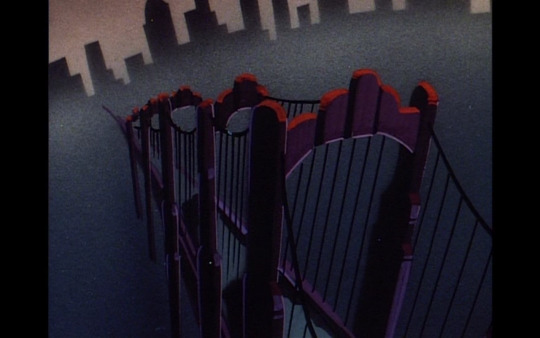



I want this as a poster.

I’m sorry, but her hairline looks like it should belong to some middle-aged dude trying to be hip from the 70′s.

Seeing Batman walk along the top of the bridge was cool. Stealthy Batman is just as great to watch as brutal Batman.
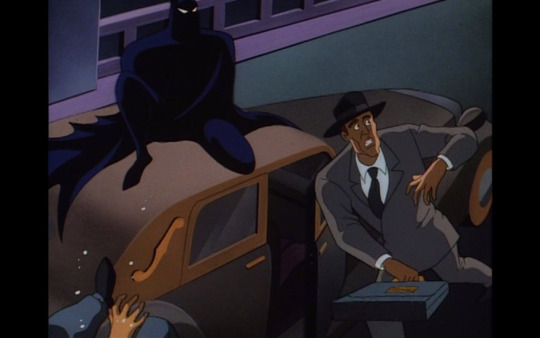
But sometimes he’s both!
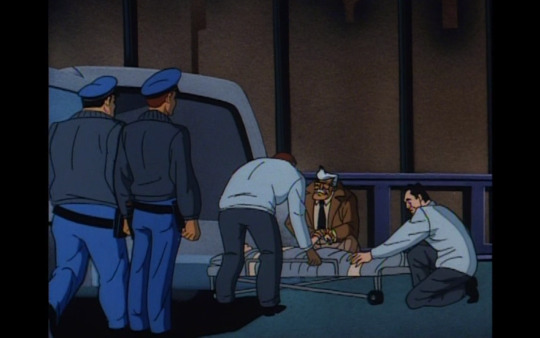
Sorry, but that judge was a lot thicker than that. Don’t skimp out.

Gordon chatting with Batman while appearing to be deep in thought, simply peering into the water was a nice touch.
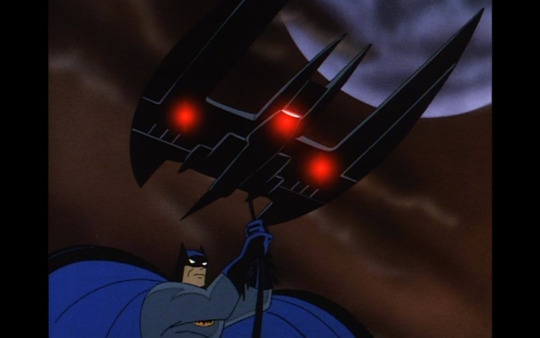
Gordon witnesses Batman disappearing for once. It would be funny if from this point on, he thought that Batman always escaped via plane.
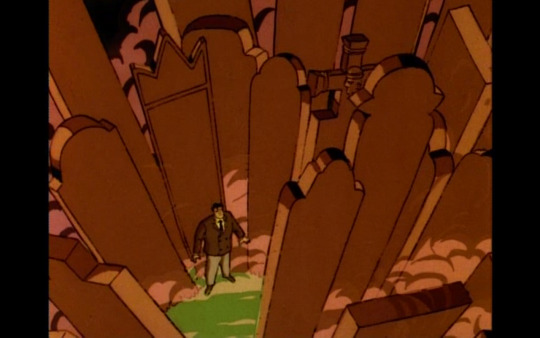
The large tombstones are cool, but this scene lacked the fluidity it required to be interesting.

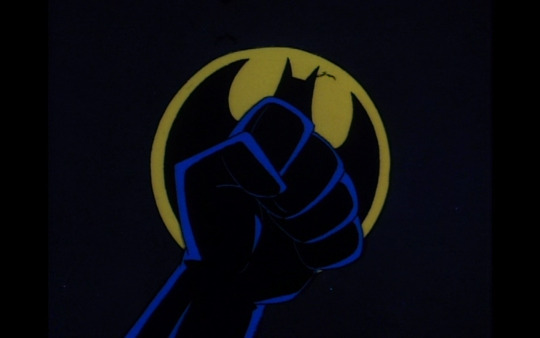
The big reveal that Batman is Bruce Wayne. Ummm... Okay.

Looks kinda like Keaton Batman.
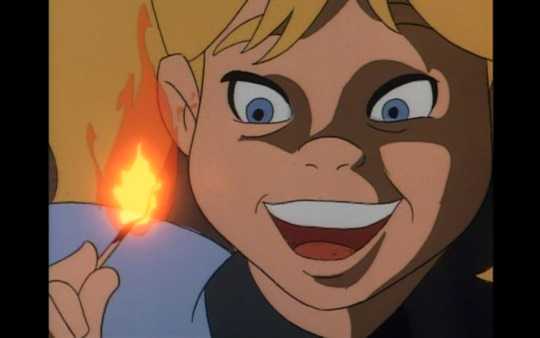
This face was really creepy. But apparently she started the fire on accident. Doesn’t really come across with a crazed look like that.
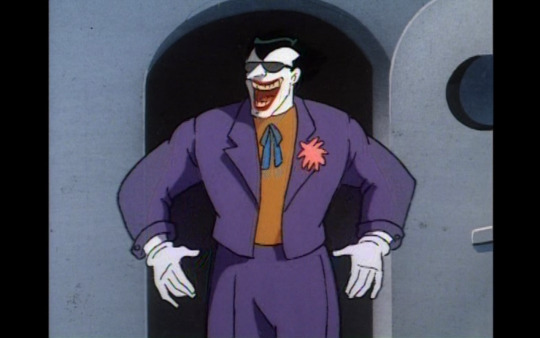
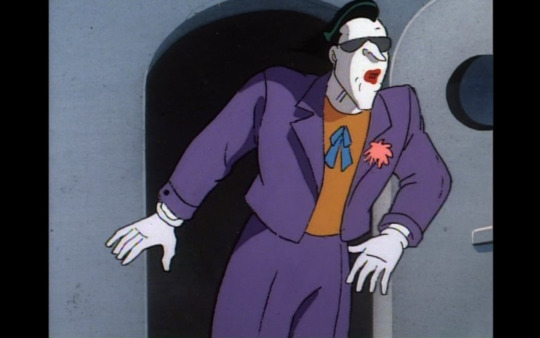

The animation didn’t destroy the episode or anything, but some of these characters have seen better days.
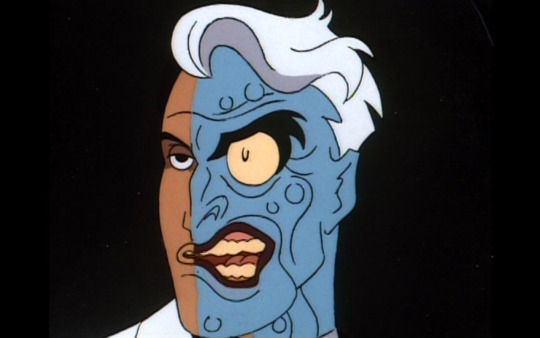

Like, I mean, it’s passable, but I’m not feeling the grotesqueness associated with Two-Face.

This was a rough shot. I’ve noticed that episodes tend to have trouble with shots featuring the Joker’s closed mouth.
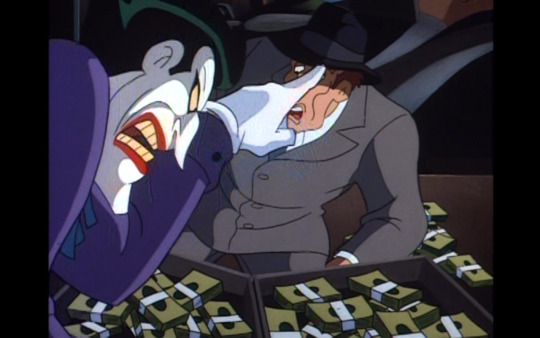
Yikes. Look at. the henchman’s facial structure. What happened, dude?

I like the Joker’s popcorn-eating as Batman’s identity is about to be revealed.
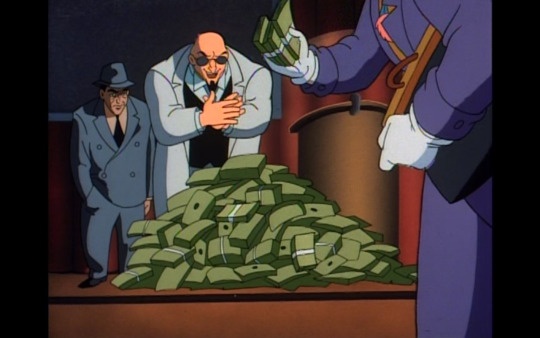
And Hugo Strange rubbing his hands together with greed was delightfully silly. I also wonder how the rogues obtained so much money. I bet most of it is Penguin’s. Joker probably contributed the cents.

Got a nice screenshot of Penguin shooting the tape.

Nice badge.
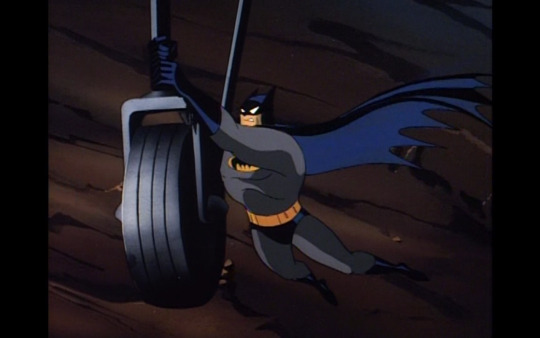
Compare this to a similar scene in the Batman Beyond pilot. One has a much easier time climbing on a plane, given the suit.
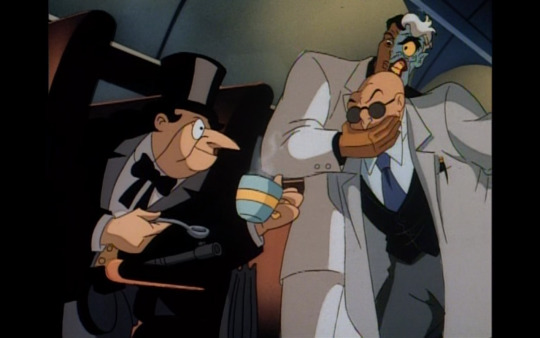
Oh, Penguin. Thinking he’s so damn sophisticated as they drag a screaming man into the sky and threaten to toss him out the door. See, that would be absolutely barbaric, but the tea.
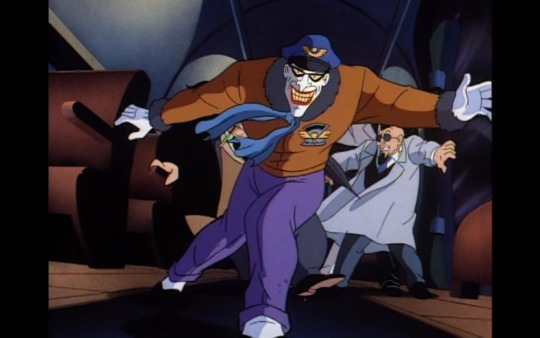
What a dreadful shot. Also, Strange’s voice actor (Ray Buktenica) knocks it out of the park with his pleas.

Once Gordon and Strange are gone, we see “Bruce” get a bit more of a smug expression that we don’t often see. This is actually Dick, and the change in expression I will praise. Still doesn’t excuse the overall scenario, though!

Char’s grade: A Next time: Heart of Steel (Part 1)
Full episode list here!
#dcau#dc animated universe#batman tas#the strange secret of bruce wayne#batman the animated series#btas#dr strange#dr hugo strange#hugo strange#batman#joker#two-tone#two face#twoface#penguin
3 notes
·
View notes
Photo

New Post has been published on https://shovelnews.com/blood-creator-theres-something-naturally-funny-about-tragedy-den-of-geek-uk/
Blood creator: 'There's something naturally funny about tragedy' - Den of Geek UK
Writer Sophie Petzal struggles with humourless TV drama. “I find it really difficult to watch crime shows where everyone’s bleak and frowny and sad.” We’ve seen too much of it, she says – dilemma-led thrillers full of grave characters whose awareness that they’re in a crime drama saps the entertainment value. “If I don’t get a sense of what you’ve lost and the joy that’s been taken from you, I don’t know what I’m rooting for.”
Besides, she adds, there’s just something naturally funny about the combination of tragedy and family dynamics. “There’s humour in the fact that it’s very inconvenient to be trying to chop sandwiches for your mother’s wake while suspecting your father of her murder.”
There’s humour too, in serving an only-one-left-in-the-bakery children’s train cake at a wake, as youngest son Michael does in Petzal’s drama Blood. There’s also comedy, and pathos, in a pair of siblings sharing a box of Bourbon biscuits—their mother’s favourite—at her graveside. Blood may boil down to “a great tragedy” says Petzal, but it’s beautifully rooted in family banalities.
Blood is the story of Cat Hogan (Carolina Main), a middle child of three who returns to her childhood home following her mother’s death. Very quickly, Cat begins to suspect her father of keeping secrets, and a satisfyingly compact mystery emerges from there. It was envisaged as a family drama rather than a thriller, but its cliff-hangers, question marks and the odd pulpy flourish give it a foot in both camps.
The series, which aired in its native Ireland in October and was stripped across a single week of November on Channel 5 here in the UK, is Petzal’s first solo drama. She’s written previously on The Last Kingdom, Medici, Riviera, Jekyll And Hyde and CBBC’s Wolfblood, but this project belonged to her and producer Jonathan Fisher, with directors Lisa Mulcahy and Hannah Quinn.
It’s been a busy twelve months—Blood was story-lined in a fortnight after being green-lit this time last year, and filmed in Ireland this summer—followed by a nerve-wracking few weeks as it aired. Petzal had convinced herself that the Irish broadcast would be the most anxiety-inducing hurdle to clear and that the UK airing would be “much of a muchness” but found that not to be the case.
“The UK is my home and it’s also one of the biggest players in television,” she explains. Airing on Channel 5 as a quality original drama, Blood attracted press attention for marking a recent shift in the station’s programming. “Suddenly you realise you’re not just going to go calmly under the radar and no-one will notice.” It felt as though there were eyes on Blood, says Petzal. “That Monday afternoon before it went out I was sort of unhinged,” she laughs. She locked herself in her flat and watched Disney clips on YouTube just to calm down. (Which ones? Out There from personal obsession The Hunchback Of Notre Dame. “I’m the biggest fan of composer Alan Menken.”)
The response to Blood was hugely positive, with good reviews appearing across the national press and even, to Petzal’s delight, on Fern Britton’s Twitter feed. “That was a funny moment, we thought ‘oh, we’ve made it now!’” Petzal laughs. She’s saved a screenshot, of course. “Then I just spent the rest of the week madly overstimulated and unable to sleep because it was too exciting and nerve-wracking, because what if the next episode is the one where they realise it’s actually shit?!” she laughs.
“It was the fact that we’d gotten away without being called frauds,” she tells me. “The fact that we’d got through the week without being torn apart by a national newspaper or somebody saying ‘this is naff as old fucking boots. What is this?!’ It felt like we’d gotten away with it.”
That sounds unnecessarily harsh on yourself, I say. “I’m not riddled with inadequacy!” she explains, but this being her first solo project made her feel “brand new all over again, in a weird way.”
“Working on other people’s shows, all you learn from that is that you’re good at working on other people’s shows and turning things in on time. You only start to work out what your style and worth and value as a writer is when you’re doing your own thing. I feel like I’m only just at the start of that.” The critical and public response to Blood, she concludes, validated all the hard work.
In Ireland and here in the UK, the drama owes a great deal to actor Adrian Dunbar, who championed the project. “I really don’t think we’d have got that early exposure and press interest had he not been in it and talking about it.” Dunbar is a deeply beloved presence, Petzal says, particularly for his work on BBC drama Line Of Duty.
Petzal is “a massive, massive fan” of that show. She and her producer re-watched all four series while filming Blood. “We’re massive fanboys and girls, which is kind of embarrassing but Adrian loves it,” she laughs.
Dunbar’s insights into his character, patriarch Jim Hogan, were a great boon to the Blood, she says. “Adrian approaches his characters with a really forensic, academic head on.” Petzal being on set during the shoot enabled conversations to take place that helped the characters evolve.
“Adrian was always pushing for Jim’s softness,” she explains. He wanted his character to be “a bit more honest and empathetic,” which worked perfectly to the drama’s advantage, says Petzal, because “the more honest and empathetic Jim is, the less people believe him!”
“One news article described Jim as having a smile that never quite reaches his eyes, which is an incredible testament to Adrian’s ability. He was able to play the menace and nuance that we wanted just in the way he stands and looks and delivers lines, which means I didn’t need to go to such an extent to reflect that menace in the lines themselves. It has a far more powerful effect for it.”
She gives “unending credit” to the cast for trusting in the project. “I’m not a known quantity, this is my first gig, I couldn’t point to a load of other things and say ‘my things tend to be a bit pulpy and weird’. Everyone had to hear me say a thousand times ‘Tone. It’s just the tone of it.’ ‘Why am I jumping out at her in a corridor?’, ‘Because it’ll look great, it’s the tone, it’s funny, it’s weird, it’s ridiculous, but go with it.’ No actor likes to be told ‘it’s just funny, do it!’”
The funny moments in Blood build character, helping to bed the drama’s more outlandish genre elements in naturalism and recognisable human behaviour. The aim, says Petzal, was always to avoid having Cat and her family act “like super-clever TV characters.” One trick, she says, was to mine her own behaviour in similar situations. It’s an exposing approach, but one that really pays off in terms of naturalism.
“When characters are arguing—and in Blood there are a fair few heavy conflicts—it’s so easy when you’re writing disagreements for one character to be clearly right and for the other to be clearly wrong.”
“I found I was writing Cat being incredibly clever and battling the family and withholding all this information that she’s learned. She was keeping the cards close to her chest and was going to play it just at the right moment… then I thought ‘That’s not what I would do.’ That’s not what any normal human being would do.”
That willingness to show vulnerability in the writing, and to include sometimes unflattering honesty makes Blood stand apart from some other dramas.
“In my heart I’m thinking, if I’m being honest, if this were me, I’d say this really hurtful thing. But often as a writer you’re thinking ‘no, the character is better than me. They’re a TV character. They’re going to do proper TV things.’ When Cat says the wrong thing, or when any character says the wrong or hurtful thing, that’s usually me putting bits of myself in there and echoing arguments and conversations I’ve had.”
One real-life conversation Petzal had that ended up in the finale in flashback involved the strange mating habits of domestic dogs. On screen, it’s a laugh-out-loud moment between husband and wife Jim and Mary, and it comes after one of the show’s most emotional sequences. The idea was to disrupt the dull cliché about women on TV suffering from serious illnesses being “these saintly frail figures. I wanted to give a sense of how Mary is this bright spark who’s hilarious and has a filthy sense of humour and what an unjust robbery this disease is. Funny bright sparks going too young.”
Making fun of serious things comes naturally to Petzal, she says. She wanted to avoid the tragedy becoming too overwrought or earnest. “It’s in human nature to make jokes.”
Knotted in with Blood’s humour and tragedy is a moral. “Without wanting to sound too pretentious, I wanted it to feel almost like a parable at the end.”
“I’ve had people say ‘why wasn’t so-and-so just honest from the beginning?’ and I have to raise an eyebrow and ask, ‘have you had parents? Are there times in your own family when things would have been simpler if family members had just told the truth?!’
“The moral of the story—which is a rather on-the-nose line delivered in episode five—is “why can’t we all just talk to each other?” and because we can’t, this is what happens.”
Blood is available now on DVD.
Source: https://www.denofgeek.com/uk/tv/blood/62160/blood-creator-there-s-something-naturally-funny-about-tragedy
0 notes
Link
Ozark season two is built on a lie, one the audience can see coming from a long way off.
It begins from the premise that Marty (Jason Bateman) and Wendy Byrde (Laura Linney) will split from the little Ozark resort town they moved to in season one once they’ve built the casino they promised to their various criminal partners. Said casino will help launder money for the Mexican cartel Marty works for, but it will also provide a slightly more legitimate business enterprise for a local crime family, the Snells, whose land will furnish a location for the casino and whose heroin trade might also provide a lucrative side enterprise for the cartel.
This complicated balancing act, with the Byrdes at its center, would seem to set up a second season all about Marty and Wendy trying to keep the casino on track while trying to keep the cartel from stomping on the Snells and the Snells from fucking everything up in a fit of pique. (Darlene Snell, played by Lisa Emery, doesn’t much like “Mexicans,” as she’s fond of pointing out, but she can come up with any number of reasons to stomp on the casino project, some of which she just pulls out of her ass in the moment.)
Yet season two of Ozark is mostly about the Byrdes trying to pretend they’re not characters in a TV show, as Marty and Wendy focus on their plan to split with their two kids for the Gold Coast of Australia once the casino is open, leaving behind whatever mess they’ve created. They give much less attention to their burgeoning criminal empire.
Leaving aside that the Byrdes are frequently the least interesting characters on their own show, perpetually trapped in moral dilemmas prompted by their life of crime (dilemmas you’d really think they would have seen coming had they watched any other crime drama ever made), the audience knows they won’t be leaving anytime soon.
The Byrdes are our point-of-view characters. The story is about their slow descent into outright criminality, juxtaposed with the way said descent changes their family, sometimes for the better (but often for the worse). If they leave the Ozarks, then there is no show.
This is a common thing for an antihero drama to try for a few episodes. The “what if I tried to escape?” story has driven arcs on just about any antihero drama you can think of, though rarely successfully. TV doesn’t handle the moment where the protagonist “refuses the call” well, because it tends to drag out that moment into long bouts of inaction. Thus, in season two of Ozark, the Byrdes are too often reactive protagonists, trying to clean up messes caused by others rather than making new messes of their own.
There are still enough good things going on that I could have written off Ozark season two as competent but ultimately not for me — but for one thing.
Watching any given frame of this series, which has earned Emmy nominations for directing and cinematography, is frequently like looking through a pool of dirty dishwater. So intent on being perceived as serious is Ozark that it never stops to shoot anything in a format other than “ultra-glum.”
Some spoilers follow, mostly in the images, which depict certain situations the characters get into.
Let me explain what I mean by starting with a shot that is, on its face, totally defensible.
Ruth talks to her dad in the Ozark season two premiere. Netflix
I call this image “defensible,” because it more or less makes sense why Ruth’s face would be half in shadow. The scene takes place in a car, in late afternoon, in a place without a lot of light sources other than the sun. If you’re following a naturalistic theory of lighting, you can more or less argue for why Ruth appears to be receding into darkness.
But I pull up this image to give you a rather dramatic example of Ozark’s primary method for lighting scenes featuring human beings. Regardless of where they are, regardless of how much light would be present, they’re always lit so that half of their face is in shadow. I spent season two trying to count times when characters weren’t lit this way, and I never got to 15, across 10 episodes where the shortest installment ran 55 minutes and several ran over an hour.
It’s not just Ruth (the teenage would-be kingpin played by Julia Garner, who was the best thing about season one and is frustratingly wasted in season two), either. It’s every character. They’re all constantly trapped between darkness and light, in a bit of not particularly subtle visual symbolism.
Wendy attends a very important meeting. Netflix Marty makes a choice. Netflix Mason reveals himself. Netflix
Now, again, I could sort of make an argument for any of the above images making sense from the point of view of “there probably would be low light levels in that situation,” especially if you accept that everybody in the Ozarks is turning off lights all of the time to save on their electric bill.
But it’s harder to make that argument for a shot that is set in a hospital room. Have you seen hospital lighting?
You’d think the nurses would turn on more lights. Netflix
Or this shot, set outside, on a sunny day. The sun is literally right behind the subject of the shot, but the director has staged the shot underneath an overhang so that the shadow lies over half the actor’s face.
The sun is right there! Netflix
This is not a problem of any one director, either. The show’s directorial crew includes esteemed Emmy nominees and winners like Alik Sakharov and Phil Abraham and Bateman himself. No, this is just how the show chooses to light every single shot, so that you always know the characters are in a murky moral gray area, caught between their darker selves and their better selves. There’s no attempt to vary this, and everything has a vaguely bluish tint over it, like the whole story takes place at 6:30 am in November.
But all of the above shots are more or less legible. Yeah, I think they’re all kind of silly as visual metaphors, but you can mostly see what’s going on, and a sufficiently skilled actor (and Ozark has plenty of those) will be able to get across just as much with only half their face as with access to their whole expression.
No, the real problems arise when Ozark stages so many of its scenes in ways that downplay visual contrast, leaving almost everything shrouded in shadow, to the point of genuine incomprehension. (At one point in watching season two, my monitor switched off, and it took me a couple of seconds to figure it out. Once I turned it back on, you couldn’t see anything that was happening anyway.)
Like, what are we supposed to make of this …
Ruth wakes up to see her father. Netflix
Or this …
Guys, you can really turn on some lights. Netflix
Or this?
A pieta! I guess? Netflix
Any one of these images might be stunning if it weren’t surrounded by so many other images that looked just like it. The last one, in particular, accompanies an emotionally powerful moment, and seeing this sort of negative image of a pieta could create something incredibly moving. But when everything is suffused with shadow, it’s harder for those moments to stand out.
The shadowy images are so bad they even swallow some of the show’s attempts at visual humor. For example, try to tell me what’s supposed to be funny about this image:
Any guesses? Netflix
The joke is that this would-be tough guy is wearing a shirt that reads “Take a Dam Ride.” Even if you don’t know who the character is, you should be able to spot the silly pun. But Ozark’s visual scheme chokes even that out.
There are some occasionally interesting visuals in Ozark season two, usually involving the sudden eruption of fire (which has a tendency to cast an unearthly but much-needed glow onto everything nearby). And I liked the season’s final image, which uses the flatter lighting of a news photograph to throw everything that’s happened into relief.
But the show’s visuals, too often, feel like a series playing at seriousness via tricks it learned on other, better shows.
This is a big, emotional moment, which would be evident even in a still if we could see the actors’ faces at all. Netflix
I can already hear Ozark fans lining up to say, “So what if it’s dark and moody? I like dark and moody!” Well, let’s take a look at a famous shot from a series Ozark is frequently compared to: Breaking Bad.
Walter White at night. AMC
Notice how much more definitive the contrast in lighting is here. Yes, you lose a bit of Walter’s face to shadow, but you can still see what’s going on, and the string of lights behind him acts as an effective visual counterpoint to the dark things he’s doing. This is a scene, set at night, that immediately tells you everything you need to know about who Walter is and what he’s doing. And if you know the series, you’ll understand that even better.
What’s more, not all of Breaking Bad was lit like this! In fact, here’s a shot from the very same episode as the shot from above, the classic “Ozymandias” (directed by Rian Johnson).
Skyler’s life falls apart. AMC
Look how powerful that shot is because of the contrast between Skyler’s raging emotions and the starkness of daylight. Her whole life has fallen apart, and the unyielding sun is going to make sure you see every iota of her grief.
But I could point to literally any other great antihero drama and find the sort of visual contrast above. Yes, they all had scenes that took place in darkness and shadow, to great effect, and they all had scenes that seemed to take place in an eerie, autumnal chill. But they also had scenes in contrast to those, where the lights are so bright that you can’t look away from the devastation onscreen.
This sort of visual discontinuity is important to an audience’s experience of a filmed story. When everything looks the same, your brain tends to slide down into a rut of numbing familiarity. Effective filmmakers use visual discontinuity, then, to jar your brain out of that complacency, to make you sit up and take notice. (The great YouTube essayist Lindsay Ellis has a wonderful video on just this topic, covering the Transformers franchise, which has a similar problem to Ozark but in an opposite direction — there, the movies have too much going on in every frame.)
Going from dark to light, from action to inaction, from cacophony to stillness are all ways to keep viewers engaged and invested. Making sure everything is muted and coolly blue is a great way to simply trick the brain into guzzling down more episodes without really thinking about what it’s watching, at least not until moving on to the next thing. It’s a way to make what’s being offered seem like it has weight, without actually doing anything weighty.
The illusion of depth without any actual there there is an Ozark specialty. By the end of season two, it’s dragged itself to exactly where you’d think it would go, and racked up quite a body count (also proving it hasn’t really learned the lessons of the shows that came before it, which did their best to hold off on killing major characters). But none of it feels as if it has any meaning beyond getting from the end of season one to the start of season three. It’s a bridge to nowhere that keeps building itself right in front of you.
Tricking viewers’ brains into continuing to just watch stuff without really engaging with it is typical of this streaming era, and especially typical of Netflix, which too often settles for shows that have the appearance of quality without actually trying to do anything worth watching. They might not be good, but so long as they look good and feature good actors and have the sorts of plot turns you’d find in better shows, your brain might think they’re just good enough to keep going.
This is the specialty of Ozark, which is admittedly not the worst show on the air, or on Netflix. But there are few shows that make me feel more like a sucker once I’ve finished watching.
Ozark is streaming on Netflix.
Original Source -> Ozark’s muddy season 2, explained in 11 incomprehensible screenshots
via The Conservative Brief
0 notes
Link
Ozark season two is built on a lie, one the audience can see coming from a long way off.
It begins from the premise that Marty (Jason Bateman) and Wendy Byrde (Laura Linney) will split from the little Ozark resort town they moved to in season one once they’ve built the casino they promised to their various criminal partners. Said casino will help launder money for the Mexican cartel Marty works for, but it will also provide a slightly more legitimate business enterprise for a local crime family, the Snells, whose land will furnish a location for the casino and whose heroin trade might also provide a lucrative side enterprise for the cartel.
This complicated balancing act, with the Byrdes at its center, would seem to set up a second season all about Marty and Wendy trying to keep the casino on track while trying to keep the cartel from stomping on the Snells and the Snells from fucking everything up in a fit of pique. (Darlene Snell, played by Lisa Emery, doesn’t much like “Mexicans,” as she’s fond of pointing out, but she can come up with any number of reasons to stomp on the casino project, some of which she just pulls out of her ass in the moment.)
Yet season two of Ozark is mostly about the Byrdes trying to pretend they’re not characters in a TV show, as Marty and Wendy focus on their plan to split with their two kids for the Gold Coast of Australia once the casino is open, leaving behind whatever mess they’ve created. They give much less attention to their burgeoning criminal empire.
Leaving aside that the Byrdes are frequently the least interesting characters on their own show, perpetually trapped in moral dilemmas prompted by their life of crime (dilemmas you’d really think they would have seen coming had they watched any other crime drama ever made), the audience knows they won’t be leaving anytime soon.
The Byrdes are our point-of-view characters. The story is about their slow descent into outright criminality, juxtaposed with the way said descent changes their family, sometimes for the better (but often for the worse). If they leave the Ozarks, then there is no show.
This is a common thing for an antihero drama to try for a few episodes. The “what if I tried to escape?” story has driven arcs on just about any antihero drama you can think of, though rarely successfully. TV doesn’t handle the moment where the protagonist “refuses the call” well, because it tends to drag out that moment into long bouts of inaction. Thus, in season two of Ozark, the Byrdes are too often reactive protagonists, trying to clean up messes caused by others rather than making new messes of their own.
There are still enough good things going on that I could have written off Ozark season two as competent but ultimately not for me — but for one thing.
Watching any given frame of this series, which has earned Emmy nominations for directing and cinematography, is frequently like looking through a pool of dirty dishwater. So intent on being perceived as serious is Ozark that it never stops to shoot anything in a format other than “ultra-glum.”
Some spoilers follow, mostly in the images, which depict certain situations the characters get into.
Let me explain what I mean by starting with a shot that is, on its face, totally defensible. (And I apologize for the watermark on these images, which were drawn from my screeners.)
Ruth talks to her dad in the Ozark season two premiere. Netflix
I call this image “defensible,” because it more or less makes sense why Ruth’s face would be half in shadow. The scene takes place in a car, in late afternoon, in a place without a lot of light sources other than the sun. If you’re following a naturalistic theory of lighting, you can more or less argue for why Ruth appears to be receding into darkness.
But I pull up this image to give you a rather dramatic example of Ozark’s primary method for lighting scenes featuring human beings. Regardless of where they are, regardless of how much light would be present, they’re always lit so that half of their face is in shadow. I spent season two trying to count times when characters weren’t lit this way, and I never got to 15, across 10 episodes where the shortest installment ran 55 minutes and several ran over an hour.
It’s not just Ruth (the teenage would-be kingpin played by Julia Garner, who was the best thing about season one and is frustratingly wasted in season two), either. It’s every character. They’re all constantly trapped between darkness and light, in a bit of not particularly subtle visual symbolism.
Wendy attends a very important meeting. Netflix Marty makes a choice. Netflix Mason reveals himself. Netflix
Now, again, I could sort of make an argument for any of the above images making sense from the point of view of “there probably would be low light levels in that situation,” especially if you accept that everybody in the Ozarks is turning off lights all of the time to save on their electric bill.
But it’s harder to make that argument for a shot that is set in a hospital room. Have you seen hospital lighting?
You’d think the nurses would turn on more lights. Netflix
Or this shot, set outside, on a sunny day. The sun is literally right behind the subject of the shot, but the director has staged the shot underneath an overhang so that the shadow lies over half the actor’s face.
The sun is right there! Netflix
This is not a problem of any one director, either. The show’s directorial crew includes esteemed Emmy nominees and winners like Alik Sakharov and Phil Abraham and Bateman himself. No, this is just how the show chooses to light every single shot, so that you always know the characters are in a murky moral gray area, caught between their darker selves and their better selves. There’s no attempt to vary this, and everything has a vaguely bluish tint over it, like the whole story takes place at 6:30 am in November.
But all of the above shots are more or less legible. Yeah, I think they’re all kind of silly as visual metaphors, but you can mostly see what’s going on, and a sufficiently skilled actor (and Ozark has plenty of those) will be able to get across just as much with only half their face as with access to their whole expression.
No, the real problems arise when Ozark stages so many of its scenes in ways that downplay visual contrast, leaving almost everything shrouded in shadow, to the point of genuine incomprehension. (At one point in watching season two, my monitor switched off, and it took me a couple of seconds to figure it out. Once I turned it back on, you couldn’t see anything that was happening anyway.)
Like, what are we supposed to make of this …
Ruth wakes up to see her father. Netflix
Or this …
Guys, you can really turn on some lights. Netflix
Or this?
A pieta! I guess? Netflix
Any one of these images might be stunning if it weren’t surrounded by so many other images that looked just like it. The last one, in particular, accompanies an emotionally powerful moment, and seeing this sort of negative image of a pieta could create something incredibly moving. But when everything is suffused with shadow, it’s harder for those moments to stand out.
The shadowy images are so bad they even swallow some of the show’s attempts at visual humor. For example, try to tell me what’s supposed to be funny about this image:
Any guesses? Netflix
The joke is that this would-be tough guy is wearing a shirt that reads “Take a Dam Ride.” Even if you don’t know who the character is, you should be able to spot the silly pun. But Ozark’s visual scheme chokes even that out.
There are some occasionally interesting visuals in Ozark season two, usually involving the sudden eruption of fire (which has a tendency to cast an unearthly but much-needed glow onto everything nearby). And I liked the season’s final image, which uses the flatter lighting of a news photograph to throw everything that’s happened into relief.
But the show’s visuals, too often, feel like a series playing at seriousness via tricks it learned on other, better shows.
This is a big, emotional moment, which would be evident even in a still if we could see the actors’ faces at all. Netflix
I can already hear Ozark fans lining up to say, “So what if it’s dark and moody? I like dark and moody!” Well, let’s take a look at a famous shot from a series Ozark is frequently compared to: Breaking Bad.
Walter White at night. AMC
Notice how much more definitive the contrast in lighting is here. Yes, you lose a bit of Walter’s face to shadow, but you can still see what’s going on, and the string of lights behind him acts as an effective visual counterpoint to the dark things he’s doing. This is a scene, set at night, that immediately tells you everything you need to know about who Walter is and what he’s doing. And if you know the series, you’ll understand that even better.
What’s more, not all of Breaking Bad was lit like this! In fact, here’s a shot from the very same episode as the shot from above, the classic “Ozymandias” (directed by Rian Johnson).
Skyler’s life falls apart. AMC
Look how powerful that shot is because of the contrast between Skyler’s raging emotions and the starkness of daylight. Her whole life has fallen apart, and the unyielding sun is going to make sure you see every iota of her grief.
But I could point to literally any other great antihero drama and find the sort of visual contrast above. Yes, they all had scenes that took place in darkness and shadow, to great effect, and they all had scenes that seemed to take place in an eerie, autumnal chill. But they also had scenes in contrast to those, where the lights are so bright that you can’t look away from the devastation onscreen.
This sort of visual discontinuity is important to an audience’s experience of a filmed story. When everything looks the same, your brain tends to slide down into a rut of numbing familiarity. Effective filmmakers use visual discontinuity, then, to jar your brain out of that complacency, to make you sit up and take notice. (The great YouTube essayist Lindsay Ellis has a wonderful video on just this topic, covering the Transformers franchise, which has a similar problem to Ozark but in an opposite direction — there, the movies have too much going on in every frame.)
Going from dark to light, from action to inaction, from cacophony to stillness are all ways to keep viewers engaged and invested. Making sure everything is muted and coolly blue is a great way to simply trick the brain into guzzling down more episodes without really thinking about what it’s watching, at least not until moving on to the next thing. It’s a way to make what’s being offered seem like it has weight, without actually doing anything weighty.
The illusion of depth without any actual there there is an Ozark specialty. By the end of season two, it’s dragged itself to exactly where you’d think it would go, and racked up quite a body count (also proving it hasn’t really learned the lessons of the shows that came before it, which did their best to hold off on killing major characters). But none of it feels as if it has any meaning beyond getting from the end of season one to the start of season three. It’s a bridge to nowhere that keeps building itself right in front of you.
Tricking viewers’ brains into continuing to just watch stuff without really engaging with it is typical of this streaming era, and especially typical of Netflix, which too often settles for shows that have the appearance of quality without actually trying to do anything worth watching. They might not be good, but so long as they look good and feature good actors and have the sorts of plot turns you’d find in better shows, your brain might think they’re just good enough to keep going.
This is the specialty of Ozark, which is admittedly not the worst show on the air, or on Netflix. But there are few shows that make me feel more like a sucker once I’ve finished watching.
Ozark is streaming on Netflix.
Original Source -> Ozark’s muddy season 2, explained in 11 incomprehensible screenshots
via The Conservative Brief
0 notes